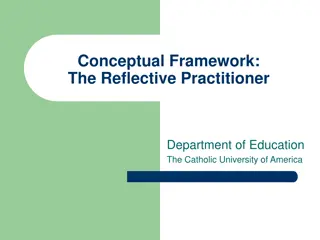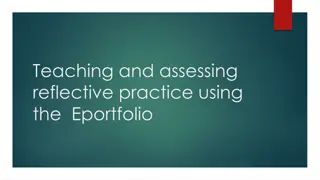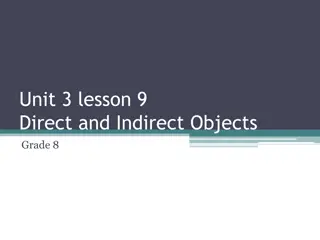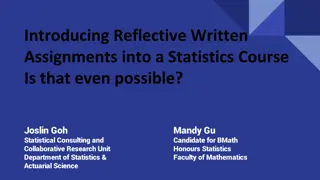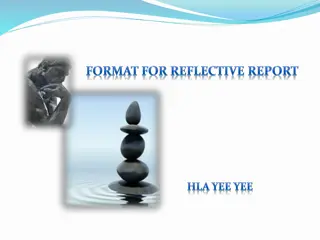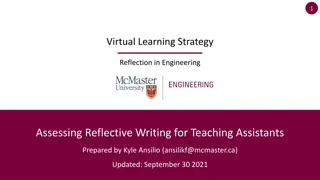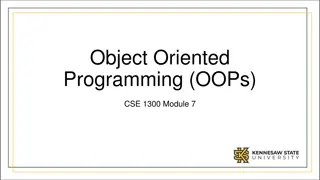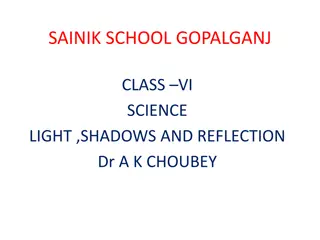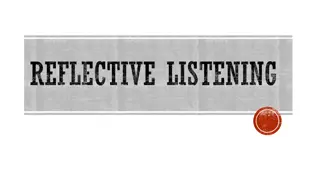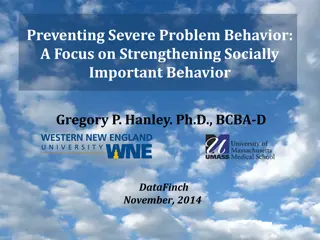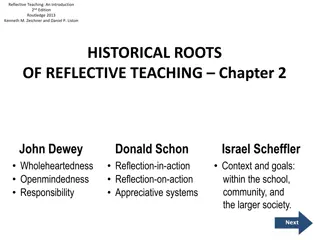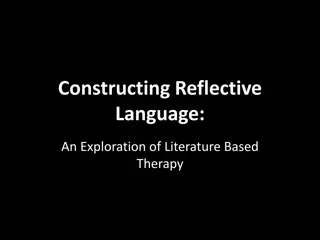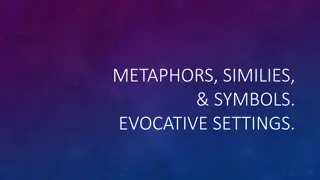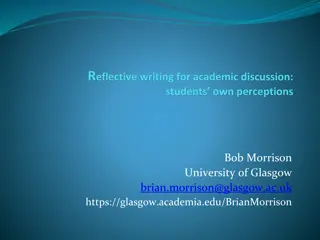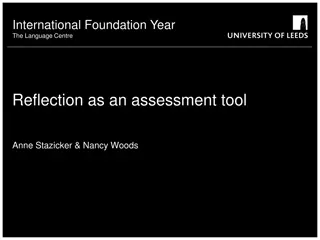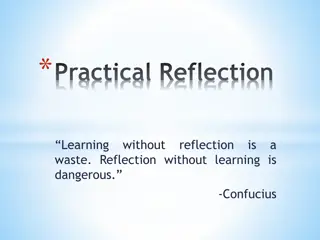Evocative Objects in Educational Research: A Reflective Paradigm
Delve into the role of evocative objects in educational research through a reflective practice approach, exploring generative and divergent analysis models, and considering alternative quality criteria. The creative analytic paradigm emphasizes the serendipitous nature of engaging with objects for a deeper understanding. Explore how these objects contribute to increasing the complexity of professional conversations and potentially reshape established viewpoints in educational research.
Download Presentation

Please find below an Image/Link to download the presentation.
The content on the website is provided AS IS for your information and personal use only. It may not be sold, licensed, or shared on other websites without obtaining consent from the author.If you encounter any issues during the download, it is possible that the publisher has removed the file from their server.
You are allowed to download the files provided on this website for personal or commercial use, subject to the condition that they are used lawfully. All files are the property of their respective owners.
The content on the website is provided AS IS for your information and personal use only. It may not be sold, licensed, or shared on other websites without obtaining consent from the author.
E N D
Presentation Transcript
A role for evocative objects within educational research: reflective practice
Research as a superordinate category Qualitative understanding, descriptive detail, depth, perspective Quantitative explanation, statistics, causality, breadth Mixed methods combination of the above regards the distinction as normative and unhelpful (Denzin & Lincoln 2011) Generative social research values generating ideas, elaborative interpretation, possibility thinking, creative responses to data, burgeoning of experience, theorising less concerned with validity and reliability
The landscape of educational research Evaluation of quality may favour central members of the category e.g. Government sponsored research studies Alternative quality criteria may have greater legitimacy where less central forms of research are categorised as part of an alternative superordinate category e.g. generative social research Art based research
Creative analytic paradigm the evocative objects model involves developing a state of being-in-relation-to the object that is both generative and divergent a serendipitous background activity rather than an exhaustive systematic active interrogation and extraction of meaning
Satellite topics and conceptual canvas Potential rhizomatic structure Some satellite topics are likely to be more developed than others Coloured circles represent evocative objects Circles with strands are satellite topics
Outcomes contributing to and increasing the complexity of the everyday professional conversation. The conversation itself is not aimed at proving or confirming anything but focuses on sharing experiences, suggesting questions and raising awareness of potential decision points, unsettling established viewpoints Our propensity to change practice is a function of the attractiveness of a set of ideas, rather than the rigour of a body of data-based conclusions (Eisner, 2005, p.89)
Insignificant detail:- Pictorial timetable Me. How do the children know what they are going to do during the daytime? In some schools they have a sort of picture line or something like that. S. We were we are it s in the pipeline we don t have one yet ! Link to virtual tour
Reading area Pictorial timeline/ timetable Coats and bags
Possible meanings: Reminder Independence Teacher s authority Communication with parents Timetable design e.g. size and nature of the images Learning support e.g. if relocated to maths area to do list / message board within HighScope approach
Applying the GDA model Alternative domains relate to fluency and flexibility possible meanings Alternative domain: support for learning Alternative domain: parental involvement Home domain: organising the day Turning towards : children leave their book bags in the reading area and incidentally get reminded of how the day is structured Alternative domain: design Alternative domain: authority of the teacher
Turning away from the timeline Consideration of different pedagogical approaches e.g. Displayed timeline: Reggio Emilia approach Classroom as the third teacher No timeline: Montessori approach Natural biorhythms of the child Active timeline: HighScope approach active plan, do review
Turning away Classroom as the third teacher: Reggio Emilia approach displayed timeline Broadening the concept of reading or learning mathematical concepts Alternative domain: support for learning Discourse of parental involvement relates to Laclau & Mouffe (hegemony/antagonism) Alternative domain: parental involvement Home domain: organising the day Self regulation/ relates to Foucault (Insidious disciplinary technologies) Alternative domain: design Alternative domain: authority of the teacher Independence/ interdependence - relates to discourse of quality re. cultural values Structure/ independence/ relate to Derrida (binary analysis)
In contrast to this elaborating interpretation the teacher s actual intention was to locate the timetable in order to support the Asperger s Syndrome child in her class.
Turkle, S. (2007) Evocative Objects things we think with,London, The MIT Press Compilation of brief reflections by a range of contributors including psychologists, philosophers, designers, architects and musicians The reflections are based on everyday objects, where the object was chosen for having some emotional and intellectual significance e.g. a cello, ballet slippers, a bracelet, a silver pin, a suitcase and apples.
There are 34 reflections in total, each preceded by a short extract selected by Turkle expressing a theoretical position intended to extend the depth of engagement with the objects. The reflective pieces have been grouped in terms of the way in which the writer has related to the object e.g. objects of play and design , objects of transition and passage , objects of discipline and desire . The final chapter revisits the reflective pieces as themselves being regarded as an evocative object also.
Ambiguity The ambiguity of remarkable moments , bafflements , active interpretations (Brown & Jones, 2001) can be productive of multiple elaborations. "By productive ambiguity, I mean that the material presented is more evocative than denotative, and in its evocation, it generates insight and invites attention to complexity. Unlike the traditional ideal of conventional research, some alternative forms of data representation result in less closure and more plausible interpretations of the meaning of the situation"(Eisner, 2005, p180).
Questioning regimes of truth: Surely even the dullest of objects are laced with songs and legends that await their bards (Harman 2008 p.455) Referring to Foucault s perspective Mac Naughton (2005) emphasised that our will to truth produce[s] inequalities because it is a violence to be enslaved within a regime of truth (p. 43)
Generative social research descriptive vividness / thick descriptive detail reduce ambiguity, evocativeness and the need for interpretation Moved away from the search for truth Moved away from being confined by boundaries of legitimacy Evocative objects
A tranquil lake rather than rat race river rapids model Evocative objects support a more rounded experience Evocative objects support a more contemplative disposition Evocative objects support divergent thinking and creativity Evocative objects can be used to support a relationship model which values the other and the relationship rather than being an interrogation of the data Raising insignificant details of experience to significance
Extra details may delete The rat race, river rapids model Research questions focus attention and filter out irrelevant details. Research questions relate to the ideal of systematic data collection and analysis. Research questions support a model of research valorising interrogation of the data.


![[PDF⚡READ❤ONLINE] Black Hole Astrophysics: The Engine Paradigm (Springer Praxis](/thumb/21503/pdf-read-online-black-hole-astrophysics-the-engine-paradigm-springer-praxis.jpg)

